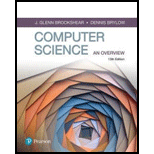
a.
Floating point notation:
The floating point is expressed with a radix point at its left and then determines the direction of the radix and the number of bits to obtain the proper conversion. The excess notations are used to convert the bits notation to the floating point to increase the accuracy.
b.
Floating point notation:
The floating point is expressed with a radix point at its left and then determines the direction of the radix and the number of bits to obtain the proper conversion. The excess notations are used to convert the bits notation to the floating point to increase the accuracy.
c.
Floating point notation:
The floating point is expressed with a radix point at its left and then determines the direction of the radix and the number of bits to obtain the proper conversion. The excess notations are used to convert the bits notation to the floating point to increase the accuracy.
d.
Floating point notation:
The floating point is expressed with a radix point at its left and then determines the direction of the radix and the number of bits to obtain the proper conversion. The excess notations are used to convert the bits notation to the floating point to increase the accuracy.
e.
Floating point notation:
The floating point is expressed with a radix point at its left and then determines the direction of the radix and the number of bits to obtain the proper conversion. The excess notations are used to convert the bits notation to the floating point to increase the accuracy.
Trending nowThis is a popular solution!

Chapter 1 Solutions
Computer Science: An Overview (13th Edition) (What's New in Computer Science)
- Assume that the numbers A= 88CC3000 and B = 84EA0000 are Typical IBM 32-bit Floating-Point Format numbers: (i) Find A + B (ii) Find A / B (iii) Convert A to the IEEE Single Precision Floating Format (iv) Convert B to the Double Precision IEEE floating point Format.arrow_forwardThis problem covers floating-point IEEE format.(a) Assuming single precision IEEE 754 format, what is the binary pattern for decimal number 6.16?(b) Assuming single precision IEEE 754 format, what decimal number is represented by this word:0 01111110 01100000000000000000000arrow_forwardShow how each of the following floating point values would be stored using IEEE-754 double precision (be sure to indicate the sign bit, the exponent, and the significand fields): 26.625arrow_forward
- Please and thank you! Convert the following IEEE-754 Floating Point notation (shown in hex) into a floating point number: 40600000 Your answer should be given in decimal, maybe with a negative sign, definitely with a decimal point somewhere.arrow_forwardJ - For the IEEE 754 single-precision floating point, what is the number, as written in binary scientific notation, whose hexadecimal representation is the following? FF80 0000arrow_forwardAssume we are using the simple model for floating-pointrepresentation as given in the text (the representation uses a 14-bitformat, 5 bits for the exponent with a bias of 15, a normalizedmantissa of 8 bits, and a single sign bit for the number):1. a) Show how the computer would represent the numbers100.0 and 0.25 using this floating-point format.2. b) Show how the computer would add the two floating-pointnumbers in Part a by changing one of the numbers so theyare both expressed using the same power of 2. c) Show how the computer would represent the sum in Partb using the given floating-point representation. Whatdecimal value for the sum is the computer actually storing?Explain.arrow_forward
- If 6.75 is represented in 8 bit binary floating point, what is the mantissa and exponent value?arrow_forwardThis problem covers floating-point IEEE format.(a) Assuming single precision IEEE 754 format, what is the binary pattern for decimal number -6.16?(b) Assuming single precision IEEE 754 format, what decimal number is represented by this word:0 01111100 01100000000000000000000(Hint: remember to use the biased form of the exponent.)arrow_forwardUsing 16-bit Normalized Floating-point notation having the format SEEEEEEMMMMMMMMM: Decode to decimal integer and/or fraction): 0 100100 101001000 =arrow_forward
- Computer Architecture: Add the following decimal numbers in biased floating point binary format an leave in biased floating point binary format to 3 digits to the right of the binary point. 7.4510 + - 3.12510 10.75 + 4.6510arrow_forwardPerform the multiplication of the following two floating point numbers using the simple floating point format :(-0.75*23)*(-0.625*22) . Do the calculation in base 10 and comment on the accuracy of your calculation. arrow_forwardWhat are the values of the mantissa and exponent if 6.75 is expressed in 8-bit binary floating point form?arrow_forward
 Systems ArchitectureComputer ScienceISBN:9781305080195Author:Stephen D. BurdPublisher:Cengage Learning
Systems ArchitectureComputer ScienceISBN:9781305080195Author:Stephen D. BurdPublisher:Cengage Learning
